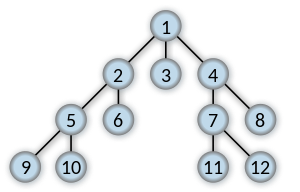How do you trace the path of a Breadth-First Search, such that in the following example:

If searching for key 11, return the shortest list connecting 1 to 11.
[1, 4, 7, 11]
Advertisement
Answer
You should have look at http://en.wikipedia.org/wiki/Breadth-first_search first.
Below is a quick implementation, in which I used a list of list to represent the queue of paths.
# graph is in adjacent list representation
graph = {
'1': ['2', '3', '4'],
'2': ['5', '6'],
'5': ['9', '10'],
'4': ['7', '8'],
'7': ['11', '12']
}
def bfs(graph, start, end):
# maintain a queue of paths
queue = []
# push the first path into the queue
queue.append([start])
while queue:
# get the first path from the queue
path = queue.pop(0)
# get the last node from the path
node = path[-1]
# path found
if node == end:
return path
# enumerate all adjacent nodes, construct a
# new path and push it into the queue
for adjacent in graph.get(node, []):
new_path = list(path)
new_path.append(adjacent)
queue.append(new_path)
print bfs(graph, '1', '11')
This prints: ['1', '4', '7', '11']
Another approach would be maintaining a mapping from each node to its parent, and when inspecting the adjacent node, record its parent. When the search is done, simply backtrace according the parent mapping.
graph = {
'1': ['2', '3', '4'],
'2': ['5', '6'],
'5': ['9', '10'],
'4': ['7', '8'],
'7': ['11', '12']
}
def backtrace(parent, start, end):
path = [end]
while path[-1] != start:
path.append(parent[path[-1]])
path.reverse()
return path
def bfs(graph, start, end):
parent = {}
queue = []
queue.append(start)
while queue:
node = queue.pop(0)
if node == end:
return backtrace(parent, start, end)
for adjacent in graph.get(node, []):
if node not in queue :
parent[adjacent] = node # <<<<< record its parent
queue.append(adjacent)
print bfs(graph, '1', '11')
The above codes are based on the assumption that there’s no cycles.